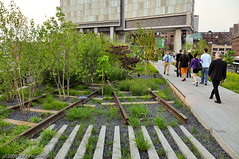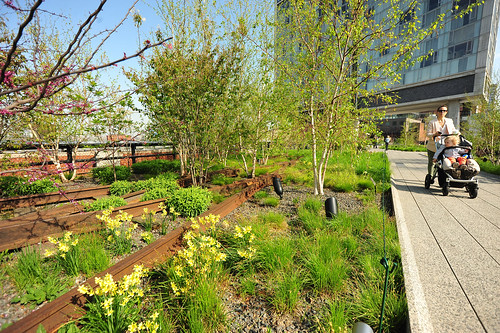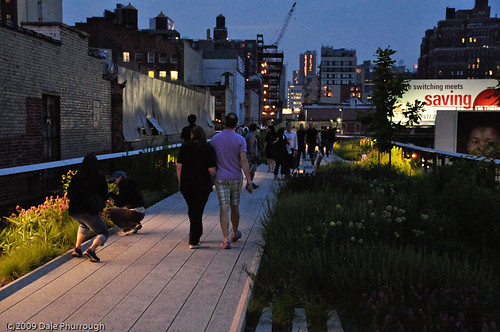NYC's celebrated High Line park is crime-free, and the city's urbanism is a reason why

Posted June 15, 2011 at 1:31PM
Many readers probably know the much-heralded High Line in lower Manhattan – a former elevated railroad bed turned linear park. It has been wildly popular, providing a nice respite from the usual hustle and bustle (and grit) of the city’s streets.
But many people (including myself) may be surprised to learn that there have been no reports of a major crime on the High Line since its opening two years ago. In an article posted on the New Urban Network, Philip Langdon suggests that (among other things) the park’s success may be attributable to the city’s unusually high density, given that it provides the park both with many users and many “eyes on the street” in nearby buildings, to appropriate Jane Jacobs’s famous phrase. He questions whether it would work so well in other cities, but applauds it in New York:
“The High Line is a testament to New York as a whole; this is one of America's safest big cities. The horrific crime epidemic of 20 years ago is, for many New Yorkers, just a memory.
“All in all, the High Line has turned out to be a shining example of civic imagination.“
I know quite a few New Yorkers who will agree with that statement.
Langdon refers his readers to a column by Michael Wilson in The New York Times, reporting some of the reasons for the High Line’s safety:
“[B]uildings are extremely adjacent. The park’s designers turned to the late, great Jane Jacobs for guidance on keeping out crime, adopting her ‘eyes on the streets’ theory, in which windows facing the street bring a feeling of security. Several buildings, including new ones like 245 Tenth Avenue, which partially leans toward the park, seem close enough to high-five someone inside.
“’Empty parks are dangerous,’ said Joshua David, one of the founders of Friends of the High Line. ‘Busy parks are much less so. You’re virtually never alone on the High Line.’”
This lends support for my belief (nicely informed by my park-expert friend Peter Harnik) that city parks and nearby density need each other to be successful. Density without nature is soulless, while a park without density is unlikely to be loved, maintained and, yes, safe.
Witold Rybczynski, author and professor of urbanism at the University of Pennsylvania, also cites density as a reason for the High Line’s success:
"[A] good part of its success is due to its architectural setting, which . . . is crowded with interesting old and new buildings. The park courses through the meatpacking district and Chelsea, heavily populated, high-energy residential neighborhoods. Very few American cities — and Manhattan is the densest urban area in the country — can offer the same combination of history and density.
"In other words, while the High Line’s success may seem to be an instance of 'build it and they will come,' in New York, as in Paris, 'they' are already there — living in the surrounding neighborhoods, working in the close-packed office buildings, touristing."
Rybczynski also notes that the park cost an amazing $30,000 per linear foot, a sum not likely to be found in many other places.
 Density isn’t the only reason the High Line is successful and safe, of course. There are limited access points, few escape routes for would-be criminals, and surveillance cameras. Alcohol is banned, and the park is locked down after 11 pm. But the combination is working.
Density isn’t the only reason the High Line is successful and safe, of course. There are limited access points, few escape routes for would-be criminals, and surveillance cameras. Alcohol is banned, and the park is locked down after 11 pm. But the combination is working.
Langdon and Rybczynski may be right that the project would be hard to replicate successfully elsewhere. From an earlier article by Langdon:
“Walkways, parks, and plazas that are much removed from the streets and sidewalks have had a problem of vulnerability for many years. Some 30 years ago, a great urban observer, William H. Whyte, pointed out that plazas and green spaces built much below grade or above grade have had a problem in attracting enough use. And the less use an urban space gets, the more likely it is to be commandeered for antisocial or criminal pursuits.”
Langdon contends that, “In most of urban America, street level is where our circulation routes belong.” I don’t dispute that. In fact, it makes a lot of sense to me. In cities, I generally like parks that are integrated into the city fabric rather than removed from it. But New York, special case that it might be, has certainly fabricated a winner in the High Line – in part because, even at elevation, it is not removed from the city but part of it. We can all be glad.
Move your cursor over the images for credit information.

